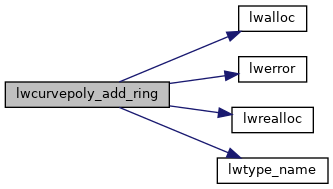◆ lwcurvepoly_add_ring()
| int lwcurvepoly_add_ring | ( | LWCURVEPOLY * | poly, |
| LWGEOM * | ring | ||
| ) |
Add a ring, allocating extra space if necessary.
The curvepolygon takes ownership of the passed point array.
Definition at line 71 of file lwcurvepoly.c.
91 if ( ! ( ring->type == LINETYPE || ring->type == CIRCSTRINGTYPE || ring->type == COMPOUNDTYPE ) )
const char * lwtype_name(uint8_t type)
Return the type name string associated with a type number (e.g.
Definition: lwutil.c:216
void void lwerror(const char *fmt,...) __attribute__((format(printf
Write a notice out to the error handler.
Definition: liblwgeom.h:457
References CIRCSTRINGTYPE, COMPOUNDTYPE, LINETYPE, LW_FAILURE, LW_SUCCESS, lwalloc(), LWDEBUG, LWDEBUGF, lwerror(), lwrealloc(), lwtype_name(), LWCURVEPOLY::maxrings, LWCURVEPOLY::nrings, LWCURVEPOLY::rings, and LWGEOM::type.
Referenced by lwcurvepoly_from_wkb_state(), and wkt_parser_curvepolygon_add_ring().
Here is the call graph for this function:

Here is the caller graph for this function:
